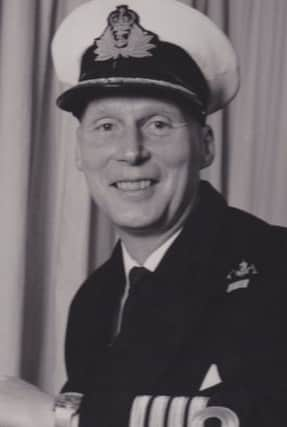Obituary: John Hervey


The placid Paisley silk-weavers who were the ancestors of Rear Admiral John Hervey would have blanched at the daring tasks his twentieth-century naval overlords asked him to do.
As a commander of nuclear-powered hunter-killer submarines, Hervey was one of a select body of modern British buccaneers who in the 1960s and 1970s stealthily explored the Arctic, gleaning high-quality intelligence on the then Soviet Union’s sea-power when, Hervey later explained, “they think no-one else is around.”
Advertisement
Hide AdAdvertisement
Hide AdIt meant trailing the Russian vessels up close – so close that with the limitations of the sonar equipment the British boats carried, together with the restrictions on its use that silent snooping imposed, the risk of collision and an unmarked, deliberately forgotten, watery grave was ever present.
The rewards were deemed worth the risk. Hervey was made OBE in 1970 for his command of the submarine HMS Warspite, in which, in 1968 and 1969, he and his crew obtained valuable and highly secret information.
Yet that same command brought for Hervey a court-martial, and, for his men, the fright of their lives, after Warspite, trailing a Soviet “Echo II” cruise-missile-carrying submarine in the Barents Sea, and unable reliably to tell its depth or distance, ran into it.
“There was an awful bang, and crushing, and scraping”, it is recalled. Warspite tilted steeply, and heeled to starboard. “There were alarms on all of the panels, red lights flashing, bells ringing.”
She swung back, hit the Soviet boat again, and heeled over a second time. Hervey, in the Control Room, oversaw an emergency procedure to surface, had engineers prevent the boat’s nuclear plant from shutting down, and set course for base at Faslane on the Clyde.
Hervey was judged to have “incurred their lordships’ displeasure” ; and though he received no punishment, so sensitive a matter was the damage that a secret sheltered anchorage on Scotland’s west coast was found so that shipwrights could make cosmetic repairs, lest it be seen by Soviet reconnaissance aircraft.
A fin was badly damaged and the conning tower was bent. Later repairs took 28 days. The world was told, when the tale leaked out, that Warspite had hit an iceberg. The incident is recounted in “The Silent Deep”, by Peter Hennessy and James Jinks (2015).
The importance of Hervey and his fellow submarine commanders, primed for action by constant danger and incident during the Cold War – his was far from the only bump – emerged when the Falklands conflict erupted with Argentina in 1982. Submariners were the men chosen to lead Britain’s force against the enemy.
Advertisement
Hide AdAdvertisement
Hide AdIn that year Hervey would be in a crucial post, that of British Naval Attache in Washington DC, while his immediate successor in 1969 as commander of Warspite, John “Sandy” Woodward, by then, like Hervey, a Rear Admiral, became commander of Britain’s Task Force battle group sailing to the South Atlantic. The Task Force Commander-in-Chief, too, Admiral Sir John Fieldhouse, at headquarters in Northwood, London, was a submariner.
Hervey negotiated vital assistance from the US Navy in matters including signals intelligence.
Even the presence of Sea Harrier jump-jets on Woodward’s flagship aircraft carrier HMS Hermes, and the carrier HMS Invincible, for which only helicopters had originally been envisaged, was owed in part to work by Hervey in a previous post at the Ministry of Defence between 1971 and 1973.
Hervey had further helped Britain’s Falklands forces make best use of electronic warfare, a new element that during the conflict was still being got used to. His recommendations, made while Deputy Chief of Allied Staff at Nato headquarters, Northwood, from 1976 -80, were by 1982 still being implemented.
Hervey retired in 1982 after a 30-year career in which he had served in an unusually large number of boats, and had commanded two destroyers, HMS Cavalier from 1966-67, and HMS Kent, from 1975-76. His first submarine command was the diesel-electric HMS Aeneas, from 1956-7. After Warspite he became Flotilla Operations Officer to Flag Officer Submarines until 1971, then commanded the Second Submarine Squadron at Plymouth from 1973-5. He was appointed CB in 1982.
A descendant of French Huguenots who came first to Scotland, then moved to London in the 1860s, John Bethell Hervey was the only child of a destroyer commander who served in the First and Second World Wars. He longed from boyhood to join the Submarine Service, after learning of the daring rescue in the United States in 1939 of submariners from USS Squalus, which sank during a test-dive.
Hervey married, in 1950, Audrey Elizabeth Mote, always called Liz, whom he met through friends at Greenwich while attending a course at the Royal Naval College there. They would have two sons and a daughter. The family followed him to postings around the world, including Canada, Malta, and Malaysia. Liz died in 2015; his children survive him. Hervey’s daughter lives in Edinburgh.
Of fellow submariners, in what has long been known as “The Trade” , Hervey, a much-loved commanding officer who took care to avoid aloofness from his men, reflected: “ I thought those are the sort of people that I’d like to be with.”
ANNE KELENY